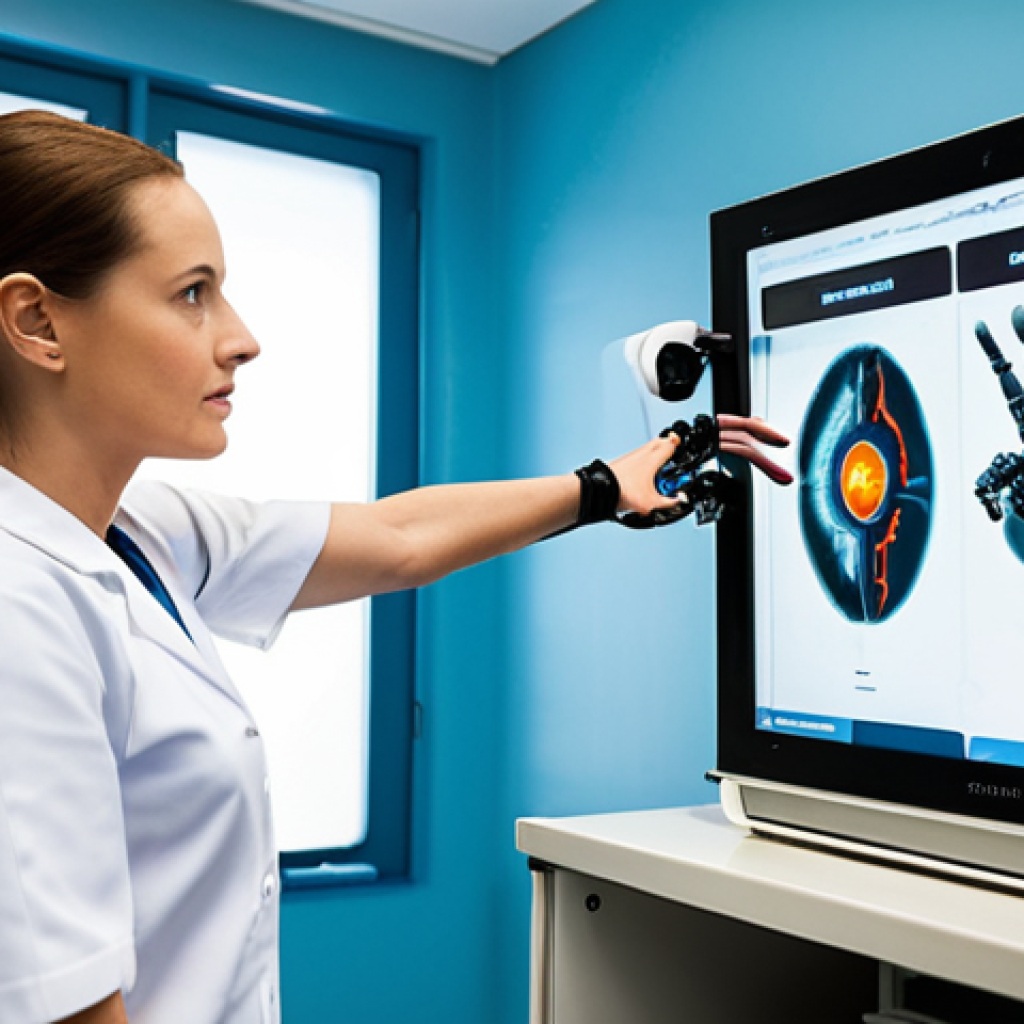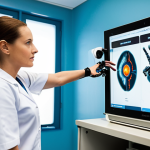The realm of physical therapy is constantly evolving, and one of the most exciting advancements is the integration of robotic rehabilitation. As someone who’s witnessed firsthand the struggles of patients recovering from injuries or strokes, the potential of these technologies is truly remarkable.
Imagine a future where personalized robotic devices guide patients through exercises with precision and consistency, leading to faster and more complete recoveries.
We’re not just talking about science fiction here; these tools are already being used in clinics and hospitals, shaping the future of rehabilitation as we know it.
The marriage of human expertise and robotic precision offers a potent combination for healing and regaining lost function. Let’s delve deeper into this fascinating intersection of technology and healthcare in the article below.
The Dawn of Robotic Assistance in Rehabilitation

The Promise of Enhanced Recovery
I remember when robotic rehabilitation first caught my attention. It was at a conference where I saw a demonstration of a robotic exoskeleton helping a stroke patient walk. The precision and support the device offered were unlike anything I’d seen before. It really struck me that this technology could provide a more consistent and intensive therapy than traditional methods alone.
The beauty of robotic assistance lies in its ability to tailor exercises to each individual’s needs. The robots can be programmed to adjust the level of assistance based on the patient’s progress, offering a personalized approach that maximizes their potential for recovery. This level of customization isn’t always possible with traditional therapy, where therapists might have to divide their attention among multiple patients.
Precision Movement and Data-Driven Progress
One of the biggest advantages of robotic rehabilitation is the precision it offers. The robots can guide patients through movements with incredible accuracy, ensuring that they’re performing exercises correctly and safely. This is especially crucial for patients with severe limitations who may not be able to control their movements independently.
Beyond the precision, robotic rehabilitation also provides valuable data about a patient’s progress. The robots can track metrics like range of motion, strength, and coordination, giving therapists a clear picture of how well the patient is responding to treatment. This data can then be used to adjust the therapy plan and optimize the patient’s recovery.
The Benefits of Robotic Rehabilitation
Increased Intensity and Repetition
I’ve observed that robotic rehabilitation allows for a higher intensity and repetition of exercises compared to traditional methods. This is significant because repetition is key to neuroplasticity – the brain’s ability to reorganize itself by forming new neural connections. By consistently repeating specific movements, patients can strengthen these connections and regain lost motor function.
In traditional therapy, therapists may need to take breaks due to fatigue or the physical demands of assisting patients. However, robots can provide consistent support for extended periods, allowing for more intense and repetitive training sessions. This can lead to faster and more significant improvements in patients’ motor skills.
Objective Assessment of Progress
Robotic rehabilitation provides objective data on patient progress. This data includes metrics like range of motion, strength, and speed. These measurements allow therapists to track improvements accurately and adjust treatment plans accordingly. In my experience, having access to such objective data leads to more informed decision-making and better patient outcomes.
Traditional assessments often rely on subjective observations, which can be influenced by factors like therapist fatigue or patient mood. With robotic assessments, the data is consistent and unbiased, providing a more reliable measure of patient progress. This objectivity also helps to motivate patients, as they can see tangible evidence of their improvements over time.
Robotics in Stroke Rehabilitation: A Game Changer
Restoring Motor Function After Stroke
Stroke is a leading cause of long-term disability, often resulting in motor impairments that affect a person’s ability to walk, use their hands, or perform daily activities. Robotic rehabilitation has emerged as a promising approach to help stroke survivors regain lost motor function.
The robots can assist patients in performing repetitive movements that stimulate neuroplasticity and promote the recovery of motor skills. For example, a robotic arm can help a patient practice reaching and grasping, while a robotic exoskeleton can support their legs during walking exercises.
Personalized Therapy for Individual Needs
Every stroke is different, and each patient has unique needs and challenges. Robotic rehabilitation allows for personalized therapy plans that address the specific impairments of each individual. The robots can be programmed to adjust the level of assistance based on the patient’s abilities and progress.
For example, a patient with severe weakness may require more assistance from the robot, while a patient with better motor control can perform exercises with less support. This level of personalization ensures that each patient receives the most effective and appropriate therapy for their individual needs.
The Role of Robotics in Spinal Cord Injury Recovery
Supporting Mobility and Independence
Spinal cord injuries can have devastating effects on a person’s mobility and independence. Robotic rehabilitation offers hope for individuals with spinal cord injuries to regain some of their lost function and improve their quality of life.
Robotic exoskeletons can provide support and assistance for walking, allowing individuals with spinal cord injuries to stand upright and move around. These devices can also help to improve balance, coordination, and cardiovascular health.
Reducing Secondary Complications
Spinal cord injuries can lead to a number of secondary complications, such as pressure ulcers, muscle atrophy, and osteoporosis. Robotic rehabilitation can help to reduce the risk of these complications by promoting movement and weight-bearing.
For example, robotic exoskeletons can help to prevent pressure ulcers by redistributing weight and reducing pressure on vulnerable areas. They can also help to maintain muscle mass and bone density by providing resistance during exercises.
Addressing Challenges and Future Directions
Cost and Accessibility
One of the main challenges facing robotic rehabilitation is the cost of the technology. Robotic devices can be expensive, making them inaccessible to many patients and healthcare facilities. However, as the technology matures and becomes more widely adopted, the cost is likely to decrease.
Efforts are also being made to develop more affordable robotic rehabilitation devices that can be used in home settings. This would make the technology more accessible to patients who cannot afford or travel to specialized clinics.
Integration with Traditional Therapy
Robotic rehabilitation is not meant to replace traditional therapy. Instead, it should be used as a complement to traditional methods, enhancing the effectiveness of treatment. The ideal approach is to integrate robotic therapy into a comprehensive rehabilitation program that includes manual therapy, exercise, and other modalities.
By combining the strengths of both robotic and traditional therapy, therapists can provide patients with the most comprehensive and effective care possible. This collaborative approach leads to better outcomes and improved quality of life for patients.
Advancements in Technology
- Haptic feedback systems for more realistic interaction
- AI-powered adaptive therapy programs
- Brain-computer interfaces for direct neural control
The Therapist’s Perspective: Integrating Robotics into Practice
Enhancing Clinical Expertise
As a therapist, I’ve seen how robotics can enhance our clinical expertise. The detailed data provided by these systems allows us to refine our treatment strategies and track patient progress more accurately. It’s not about replacing the therapist; it’s about augmenting our abilities with advanced tools.
The ability to personalize therapy based on real-time data and patient feedback is invaluable. It allows us to address specific needs and challenges more effectively, leading to better outcomes and increased patient satisfaction.
Collaboration and Teamwork
Integrating robotics into rehabilitation requires a collaborative approach. Therapists, engineers, and patients need to work together to design and implement effective treatment plans. This interdisciplinary collaboration is essential for maximizing the benefits of the technology.
I’ve found that involving patients in the process of selecting and customizing their robotic therapy is crucial for their engagement and motivation. When patients feel like they are actively participating in their recovery, they are more likely to adhere to the treatment plan and achieve their goals.
Real-World Examples and Case Studies
Success Stories in Stroke Recovery
I recall a patient named Sarah who had a severe stroke that left her with limited use of her left arm. She was initially discouraged and frustrated by her lack of progress with traditional therapy. However, after incorporating robotic rehabilitation into her treatment plan, she began to see significant improvements.
The robotic arm helped her practice reaching and grasping movements with precision and consistency. Over time, she regained enough motor control to perform everyday tasks like brushing her hair and preparing meals. Sarah’s success story is a testament to the power of robotic rehabilitation in stroke recovery.
Improved Mobility with Spinal Cord Injury
Another patient, Michael, had a spinal cord injury that left him unable to walk. He was determined to regain his mobility and independence. With the help of a robotic exoskeleton, he was able to stand upright and walk again.
The exoskeleton provided the support and assistance he needed to move his legs, while also helping to improve his balance and coordination. Michael’s journey to recovery was challenging, but he persevered and ultimately achieved his goal of walking again. His story inspires others with spinal cord injuries to pursue robotic rehabilitation and strive for a better quality of life.
| Feature | Traditional Therapy | Robotic Rehabilitation |
|---|---|---|
| Intensity and Repetition | Limited by therapist fatigue and patient endurance | High intensity and repetition can be sustained |
| Precision and Accuracy | Dependent on therapist’s skill and consistency | Precise and consistent movements guided by robots |
| Data Collection | Subjective observations and manual measurements | Objective data on range of motion, strength, and speed |
| Personalization | Limited by therapist’s time and resources | Customized therapy plans based on individual needs |
| Cost | Lower upfront cost but can require long-term sessions | Higher upfront cost but may reduce overall therapy duration |
Wrapping Up
As we’ve explored, robotic rehabilitation is revolutionizing the way we approach recovery from strokes and spinal cord injuries. From enhancing precision to providing data-driven insights, the benefits are undeniable. While challenges remain, the future looks promising as technology advances and becomes more accessible, ultimately offering hope and improved outcomes for patients on their journey to recovery.
Helpful Information
1. Consider attending a robotic rehabilitation demo day at a local hospital or clinic to see the technology in action.
2. Check with your insurance provider about coverage for robotic rehabilitation therapies, as coverage varies widely.
3. If you’re a therapist, look into continuing education courses on robotic rehabilitation to expand your skill set and knowledge.
4. Explore online resources and patient forums to connect with others who have experience with robotic rehabilitation.
5. Stay updated on the latest advancements in robotic rehabilitation by following relevant journals and industry news.
Key Takeaways
Robotic rehabilitation offers enhanced precision and personalized therapy, leading to better patient outcomes. Repetition and intensity in robotic therapy accelerate neuroplasticity. Objective data tracking allows for informed adjustments to treatment plans. The integration of robotics with traditional therapy creates a holistic approach to rehabilitation. Overcoming cost barriers and improving accessibility are crucial for wider adoption.
Frequently Asked Questions (FAQ) 📖
Q: What specific conditions or injuries can robotic rehabilitation devices effectively address?
A: From what I’ve seen working with patients, robotic rehabilitation is showing promise for a wide range of conditions. Think stroke recovery, spinal cord injuries, traumatic brain injuries, and even orthopedic rehabilitation after surgeries like knee or hip replacements.
The beauty is that these devices can be tailored to individual needs, providing targeted assistance and feedback to improve motor control, strength, and coordination.
It’s not a magic bullet, of course, but it can be a valuable tool in a comprehensive rehabilitation program.
Q: How does robotic rehabilitation compare to traditional physical therapy methods? Is it more effective, and what are the key differences?
A: That’s the million-dollar question, isn’t it? It’s not necessarily about being “more effective” in every single case, but rather offering unique advantages.
Traditional therapy relies heavily on the therapist’s manual skills and guidance. Robotic rehab can provide more consistent and precise movements, allowing for higher repetition rates and potentially accelerating learning.
Also, the data these robots collect can be incredibly valuable for tracking progress and adjusting treatment plans. I’ve personally witnessed some patients who plateaued with traditional therapy start making significant gains with the addition of robotic assistance.
However, the human connection and personalized feedback from a skilled therapist remain crucial. It’s more about finding the right balance and using the tools appropriately.
Q: Are there any significant drawbacks or limitations to consider when using robotic rehabilitation? What about cost and accessibility?
A: Absolutely, it’s not all sunshine and roses. One of the biggest hurdles is the cost. These robots are expensive, which limits their availability, especially in smaller clinics or rural areas.
Also, not every patient is a good candidate. Some people might find the robotic assistance uncomfortable or even intimidating. And while the technology is advancing rapidly, it’s still not perfect.
You need trained professionals to operate and maintain these devices, and there’s always the risk of technical glitches. From what I understand, research is ongoing to address these challenges and make robotic rehab more accessible and effective for a wider range of patients.
📚 References
Wikipedia Encyclopedia
구글 검색 결과
구글 검색 결과
구글 검색 결과
구글 검색 결과
구글 검색 결과


